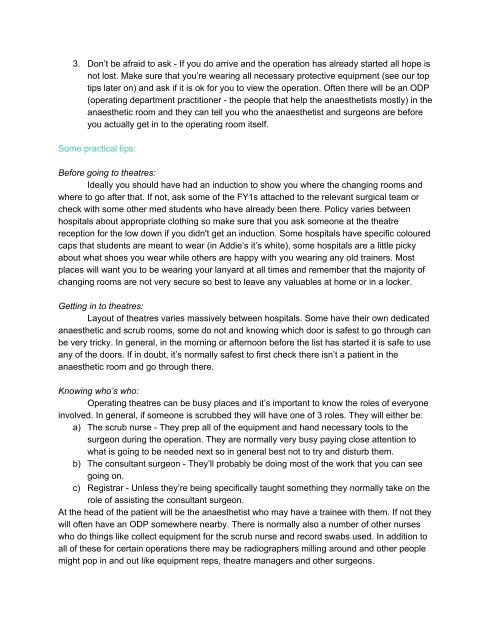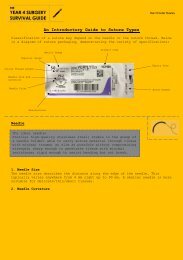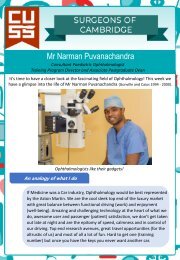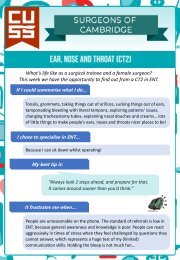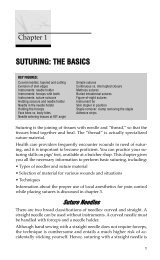Theatre Etiquette Guide 2019
Create successful ePaper yourself
Turn your PDF publications into a flip-book with our unique Google optimized e-Paper software.
3. Don’t be afraid to ask - If you do arrive and the operation has already started all hope is<br />
not lost. Make sure that you’re wearing all necessary protective equipment (see our top<br />
tips later on) and ask if it is ok for you to view the operation. Often there will be an ODP<br />
(operating department practitioner - the people that help the anaesthetists mostly) in the<br />
anaesthetic room and they can tell you who the anaesthetist and surgeons are before<br />
you actually get in to the operating room itself.<br />
Some practical tips:<br />
Before going to theatres:<br />
Ideally you should have had an induction to show you where the changing rooms and<br />
where to go after that. If not, ask some of the FY1s attached to the relevant surgical team or<br />
check with some other med students who have already been there. Policy varies between<br />
hospitals about appropriate clothing so make sure that you ask someone at the theatre<br />
reception for the low down if you didn't get an induction. Some hospitals have specific coloured<br />
caps that students are meant to wear (in Addie’s it’s white), some hospitals are a little picky<br />
about what shoes you wear while others are happy with you wearing any old trainers. Most<br />
places will want you to be wearing your lanyard at all times and remember that the majority of<br />
changing rooms are not very secure so best to leave any valuables at home or in a locker.<br />
Getting in to theatres:<br />
Layout of theatres varies massively between hospitals. Some have their own dedicated<br />
anaesthetic and scrub rooms, some do not and knowing which door is safest to go through can<br />
be very tricky. In general, in the morning or afternoon before the list has started it is safe to use<br />
any of the doors. If in doubt, it’s normally safest to first check there isn’t a patient in the<br />
anaesthetic room and go through there.<br />
Knowing who’s who:<br />
Operating theatres can be busy places and it’s important to know the roles of everyone<br />
involved. In general, if someone is scrubbed they will have one of 3 roles. They will either be:<br />
a) The scrub nurse - They prep all of the equipment and hand necessary tools to the<br />
surgeon during the operation. They are normally very busy paying close attention to<br />
what is going to be needed next so in general best not to try and disturb them.<br />
b) The consultant surgeon - They’ll probably be doing most of the work that you can see<br />
going on.<br />
c) Registrar - Unless they’re being specifically taught something they normally take on the<br />
role of assisting the consultant surgeon.<br />
At the head of the patient will be the anaesthetist who may have a trainee with them. If not they<br />
will often have an ODP somewhere nearby. There is normally also a number of other nurses<br />
who do things like collect equipment for the scrub nurse and record swabs used. In addition to<br />
all of these for certain operations there may be radiographers milling around and other people<br />
might pop in and out like equipment reps, theatre managers and other surgeons.


